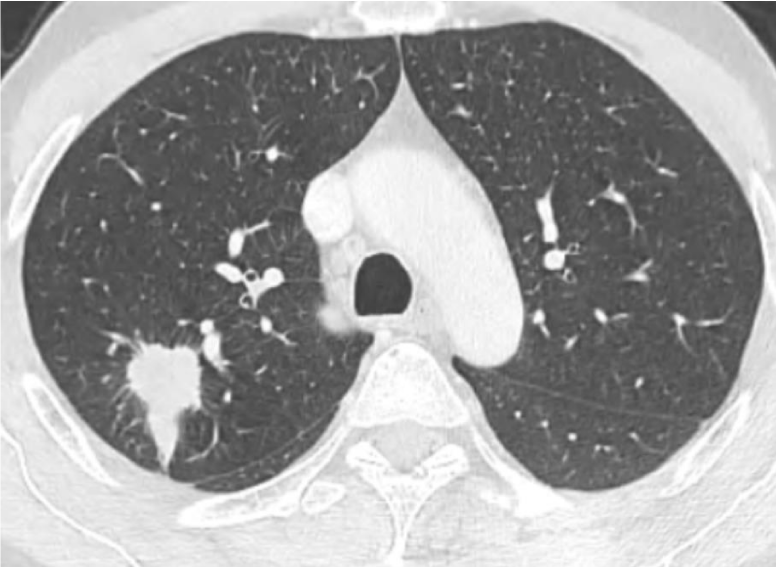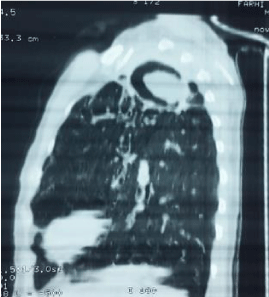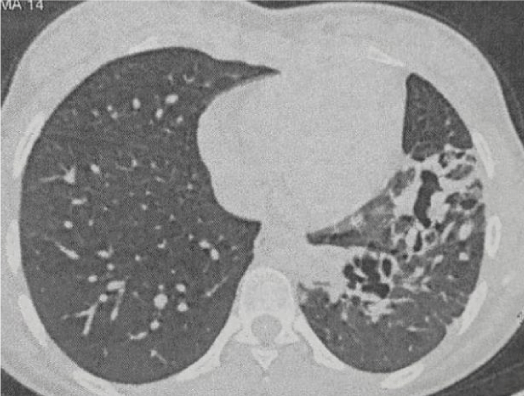Surgical Outcomes of Pulmonary Lobectomies between Benign and Malignant Diseases: About 162 Cases
H Harmouchi1*, FZ Ammor1, L Bellirej1, FZ Lamouime1, M El Ghaouti1, M Lakranbi1,2, Y Ouadnouni1,2 and M Smahi1,2
1/sup>Department of Thoracic Surgery, CHU Hassan II of Fez-Morocco, Morocco2Faculty of Medicine and Pharmacy, Sidi Mohamed Ben Abdallah University, Morocco
*Address for Correspondence: H Harmouchi Hicham, Thoracic surgery department, CHU Hassan II of Fez-Morocco, BP: 30000, Morocco, Tel: +002-126-641-531-56; E-mail: harmouchi.hicham@gmail.com
Submitted: 16 February 2020; Approved: 17 March 2020; Published: 19 March 2020
Citation this article: Harmouchi H, Ammor FZ, Bellirej L, Lamouime FZ, Ghaouti M, et al. Surgical Outcomes of Pulmonary Lobectomies between Benign and Malignant Diseases: About 162 Cases. Open J Surg. 2020;4(1): 021-024.
Copyright: © 2020 Harmouchi H, et al. This is an open access article distributed under the Creative Commons Attribution License, which permits unrestricted use, distribution, and reproduction in any medium, provided the original work is properly cited
Keywords: Lobectomy; Disease; Lung; Thoracotomy
Download Fulltext PDF
Introduction: Lung lobectomy is an anatomical resection which can be performed for benign and malignant diseases. The surgical outcomes of this intervention differ according the two kinds of pathologies. Here in we report our experience in lung lobectomy between benign and malignant affections.
Material and methods: Among 162 patients, over a period of 8 years, there were 120 and 42 cases operated respectively by lung lobectomy for benign (group A) and malignant diseases (group B).
Results: In group A, the median age was 34.7 years old against 54.95 in group B. the tuberculosis was the main pathological antecedent in group A (37 patients: 30.8%), and chronic smoking in group B (19 patients: 45.23%). in the two groups, hemoptysis was the first functional sign leaving the patient to consult (70% in group A versus 30.9% in group B). The etiologies were predominated in group A by bronchiectasis (38 patients: 31.6%), hydatid cyst of lung (31 patients: 25.8%). Therefore, non small cell lung cancer was the main pathology of malignant diseases (28 patients: 66.66%), followed by tumor carcinoid (5 patients: 11.9%). The spirometry showed a value of FEV1 of 1.8 Liters in group A, against 2.86 Liters in group B. Either in group A or B, all patients were approached by a posterolateral thoracotomy. The rate of morbidity was 22.5% (27 patients) in the group A, against 14.28% (6 patients) in the group B. Therefore, the rate of mortality was 7.14% (3 patients) in the group A, and 2.5% (3 patients) in the group B.
Conclusion: We conclude that pulmonary lobectomy can be performed with an acceptable rate of morbidity and mortality, even that all patients were approached by thoracotomy. Also, the rate of morbidity is high in the group of benign diseases compared to malignant diseases after a lung lobectomy.
Introduction
Pulmonary lobectomy was performed firstly in 1891 by Tuffier [1], and presents the main surgical procedure of the anatomical lung resection. For a long time, lung lobectomy was performed mainly for infectious diseases, especially for tuberculosis. Currently, due to development of antibiotic treatments and progress of the methods concerning lung cancer screening, the essential indication for this intervention remains lung cancer predominated by Non Small Cell Lung Cancer (NSCLC). Therefore in Morocco, because of the low socio-economic level and illiteracy of certain populations, tuberculosis and hydatid cyst are still endemic, which explains the predominance of lung lobectomy for infectious diseases in our context. For benign diseases (especially for infectious and inflammatory affections), lung lobectomy is recognized difficult compared to the malignant diseases, because of the importance of adhesions between the parietal pleura and lung. In this study, we will try to summarize the particularities of lung lobectomy between these two types of pathologies.
Materials and Methods
This study was monocentric, retrospective, performed into our department of thoracic surgery CHU Hassan II Fez over a period of 8 years (from 01 January 2010 to 31 December 2017). According to the operative report, all patients undergoing pulmonary lobectomy were included. We have collected in total 162 patients, divided into two groups: Group A including 120 patients operated for benign diseases, and Group B including 42 patients operated for malignant diseases. The criteria of benignity or malignancy were retained from the histological study of the operative specimen. We have excluded all patients with incomplete medical records, or located outside the specified period, or the surgical procedure was a lobectomy associated to another pulmonary resection. Our objective is to compare the clinical, paraclinical, and operative results of each group, and specify the surgical characteristics, and the postoperative complications.
Results
In this study, it was 120 patients operated by lung lobectomy for benign diseases (Group A), and 42 patients for malignant diseases (Group B). Tables 1-3 show more precisely the results of this study. In group A, it was 70 men and 50 women, with a median age of 34.7 years old. In group B, it was 32 men and 10 women, with a median age of 54.95 years old. Pathological history was predominated in group A by tuberculosis in 37 patients (30.8%) followed by repetitive pneumopathies in 10 patients (8.3%), and in group B by chronic smoking in 19 patients (45.23%) followed by chest pain in 12 patients (28.57%). Hemoptysis was the main functional sign in the two groups (70% in group A versus 30.9% in group B). In group A, the etiologies were predominated by bronchiectasis in 38 patients (31.6%), hydatid cyst of lung in 31 patients (25.8%), and aspergilloma in 29 patients (24.1%). In the group B, the etiologies were predominated by non-small cell lung cancer in 28 patients (66.66%) (Figure 1), and carcinoid tumor in 5 patients (11.9%). The evaluation of the respiratory function in our department is the spirometry and calculation of the forced expiratory volume in one second FEV1 whose the average value was 1.8 liters in group A and 2.86 liters in group B.
In both groups, the approach was a posterolateral thoracotomy in all patients, and the extrapleural plane was performed in 5 patients (11.90%) in Group B, against 41 patients (34.16%) in group A.
The rate of morbidity was 22.5% (27 patients) in the group of benign diseases, against 14.28% (6 patients) in the group of malignant diseases. For the complications after surgery, postoperative bleeding was recorded in 10 patients (8.3%) in group A, and in 2 patients (4.76%) in group B. the prolonged air leak was marked only in the group A in 5 patients (4.1%). The postoperative atelectasis was 5% (6 patients) in group A, against 2.3% (1 patient) in group B. Therefore, the rate of mortality was 7.14% (3 patients) in the group A, and 2.5% (3 patients) in the group B. the median of follow-up was 2.5 years, marked only by recurrence of the tumoral pathology in the group B in 2 patients (4.7%).
Discussion
Benign diseases (Figure 2,3), predominated in this study by parenchymal sequela of tuberculosis (bronchiectasis and aspergilloma, and destroyed lobe) are characterized by cicatricial, fibrous and retractile lesions, associated with a tight pleural symphysis, also deformation and loss of anatomical landmarks of the bronchovascular pedicle, complicated sometimes by the presence of calcified sclerous adenopathies that adhere intimately to the arteries and bronchi [2,3]. All these lesions are complicated by a systemic hypervascularisation by hypertrophic bronchial and parietal arteries [2]. All these particularities explain our results in this study, especially the difficult surgery for the group A, and the rate of morbidity and mortality in the immediate postoperative period the thing which was described by Kouritas and al in their article published in 2017 [4]. Firstly, the median age was high in the group A compared to group B, because of the predominance of tuberculosis in the young population. The low value of FEV1 in the group of benign diseases is explained by the underlying lung damage, unlike malignant diseases where the lung is healthy apart from the nodule or mass (figure 1).
All patients in the two groups were approached by a posterolateral thoracotomy conservative of chest wall muscles. This conservation of muscles, especially the latissimus dorsi muscle allows to perform a thoracomyoplasty in case of bronchopleural fistula. The protection of the bronchial stump is realized by a pleural flap or by an interostal muscle to avoid this serious complication which requires a long time of follow-up. Any VATS lobectomy (Video-Assisted Thoracic Surgery) has been realized because of the absence in our department of the material needed for this way. In addition, according to several studies VATS lobectomy allows a low rate of morbidity and mortality compared to open surgery, and decreases the duration of hospitalization and postoperative pain [5,6]. The extrapleural plane was approached more in the benign diseases, because of reasons described in the beginning of this discussion, especially the pleural adhesions. Lymph node dissection was performed in all patients of the group B. according to Zhang and al, with an open thoracotomy, mediastinal dissection is performed with efficacy if it is compared to VATS lobectomy [7]. In a general way, the rate morbidity was high in the group A compared to the group B. Operative bleeding, atelectasis and prolonged air leakage were important in the group of benign diseases, because of the systemic hypervascularization and pleural adhesions. It is still necessary to state that the mortality rate was equal in both groups, but it was recorded within 30 days after surgery in the benign diseases. Therefore, in the malignant diseases it was recorded 1 years old after the intervention.
The limitation of this study can be marked by the approach which was a thoracotomy in all patients despite the progress of the VATS worldwide. The difference of number between the two groups presents also a limitation of this study.
Conclusions
In this study, we concluded that lobectomy of lung for benign diseases is associated with a high risk of morbidity compared to the group of malignant diseases, which is explained by the presence of pleural adhesions, and the underlying pathology of lung. Also, lung lobectomy in performed with an acceptable rate of morbidity and mortality taking into account that all patients were approached by a thoracotomy.
- Tuffier T. De la resection du sommet du poumon. Semin Med Paris. 1891; 2: 202.
- Kilani T, Boudaya MS, Zribi H, Ouerghi S, Marghli A, Mestiri T, et al. La chirurgie dans la tuberculose. 2015; 2: 140-158. https://bit.ly/2xFAs5L
- Mordant P, Badiaa A, Le Pimpec-Barthes F, Riquet M. Chirurgie pulmonaire dans la tuberculose et les mycobacterioses atypiques Thoracic surgery in tuberculosis and non-tuberculous mycobacterial diseases. Revue de Pneumologie clinique. 2012; 68: 77-83. https://bit.ly/2IV6M6Z
- Kouritas VK, Kefaloyannis E, Tcherveniakov P, Milton R, Chaudhuri N, Brunelli A, et al. Do pleural adhesions influence the outcome of patients undergoing major lung resection? Interact Cardiovasc Thorac Surg. 2017; 25: 613-619. PubMed: https://www.ncbi.nlm.nih.gov/pubmed/28962506
- Falcoz PE, Puyraveau M, Thomas PA, Decaluwe H, Hurtgen M, Petersen RH, et al. Video-assisted thoracoscopic surgery versus open lobectomy for primary non-smallcell lung cancer: A propensity-matched analysis of outcome from the European Society of thoracic surgeon database. Eur J Cardiothorac Surg 2016; 49: 602-609. PubMed: https://www.ncbi.nlm.nih.gov/pubmed/25913824
- Bendixen M, Jorgensen OD, Kronborg C, Andersen C, Licht PB. Postoperative pain and quality of life after lobectomy via video-assisted thoracoscopic surgery or anterolateral thoracotomy for early stage lung cancer: A randomised controlled trial. Lancet Oncol. 2016; 17: 836-844. PubMed: https://www.ncbi.nlm.nih.gov/pubmed/27160473
- Zhang W, Wei Y, Jiang H, Xu J, Yu D. Thoracotomy is better than thoracoscopic lobectomy in the lymph node dissection of lung cancer: a systematic review and meta-analysis. World J Surg Oncol. 2016; 14: 290. PubMed: https://www.ncbi.nlm.nih.gov/pubmed/27855709/




Sign up for Article Alerts